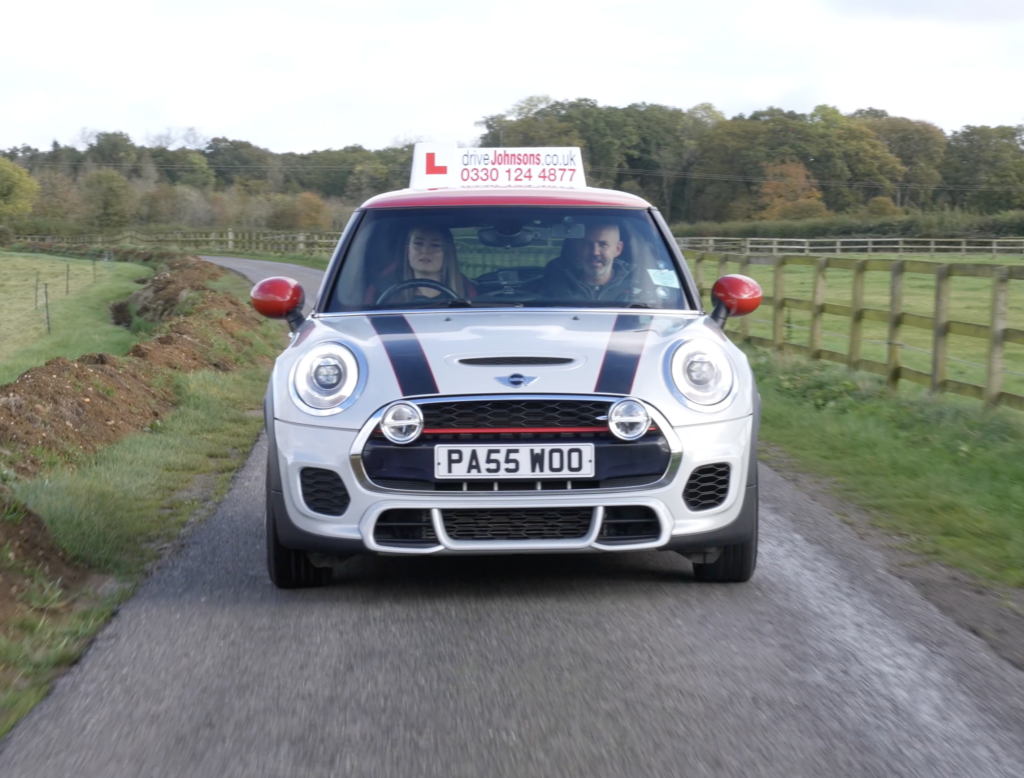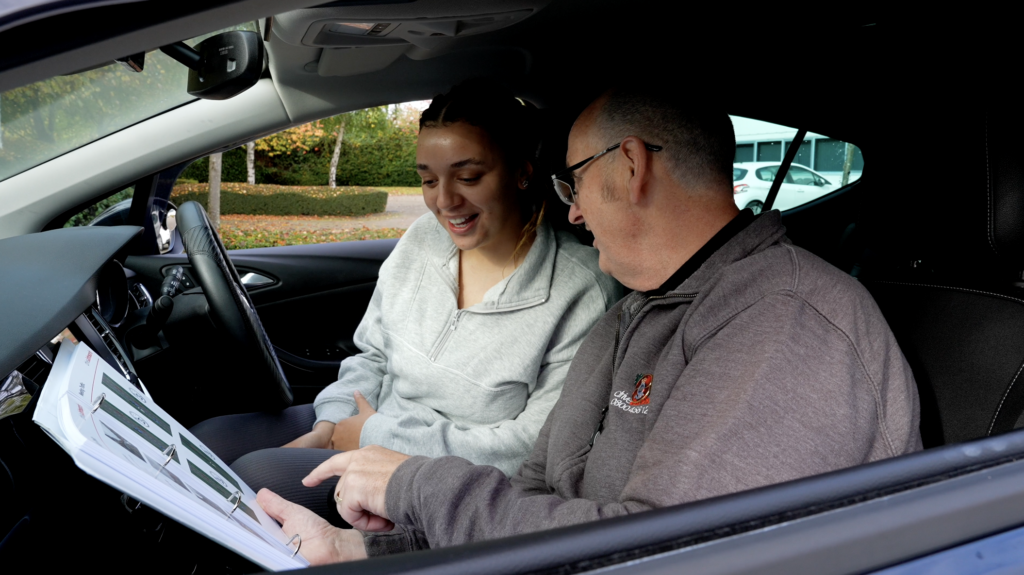ADHD is short for attention deficit hyperactivity disorder and is a neurodevelopmental condition. It affects people’s behaviour, causing inattentiveness, hyperactivity and impulsiveness.
Learning to drive with ADHD
Many people have ADHD. In the UK, research estimates that about 3-4% of adults have the condition, with about three-quarters of those being men. Every year, a high volume of people with ADHD learn to drive and at driveJohnson’s, we’ve helped many people with ADHD to pass their driving test quickly and safely. Check out our detailed guide below for more information on learning to drive with ADHD.
- What are the symptoms of ADHD?
- Can people with ADHD drive?
- How to drive with ADHD
- Strengths you may experience in driving with ADHD
- Challenges you may find in driving with ADHD
- Top tips on how to pass your driving test with ADHD
- Can you drive on ADHD medication?
- Do you have to tell the DVSA if you have ADHD?
What are the symptoms of ADHD?
Someone with ADHD may struggle with concentration, with symptoms such as:
- Forgetfulness
- Losing or misplacing things easily
- Being easily distracted
- Making lots of mistakes
- Having difficulty organising tasks, being unable to prioritise
- Constantly jumping from task to task, being easily distracted
- Being unable to stick to a task that is boring or takes time
- Showing a lack of attention to detail
- Struggling to listen
- Struggling to follow instructions
Someone with ADHD can also be prone to hyperactivity and impulsive behaviour, which can manifest itself in the following ways:
- Always fidgeting
- Struggling with concentration
- Showing excessive physical movement and feeling restless
- Having difficulty keeping quiet and often interrupting others
- Having extreme impatience
- Acting without thinking of the consequences
- Having little to no sense of danger
- Having mood swings, irritability and a quick temper
- Struggling to deal with stress
People with ADHD tend to either have one or both groups of symptoms.
Can people with ADHD drive?
Due to the symptoms listed above, drivers with ADHD can statistically face higher risks when driving. However, this does not need to be the case. With support from the right driving instructor, a driver with ADHD can not only pass quickly and safely but ensure that they establish excellent driving patterns to become superb drivers for life.
Depending on the severity of symptoms, ADHD will only be a barrier for a small minority of people. For the majority of people, driving with ADHD is absolutely achievable and we have helped many people with the condition to pass first time.
How to drive with ADHD
It’s important to bear in mind your particular symptoms and how they may affect you to ensure that you stay safe when driving.
Whilst some people who have ADHD thrive under pressure, for others it can cause a lot of difficulties, leading them to feel overwhelmed. Depending on the symptoms that someone has, they may find ADHD gives them advantages when it comes to learning to drive, whilst others may find it more challenging.
Strengths you may experience in driving with ADHD
Strengths that some people with ADHD may be able to use when learning to drive:
- Enthusiasm and energy to succeed – many people with ADHD experience high energy levels. This can be channelled into a drive to achieve and get things done, which can be very helpful when it comes to learning to drive and passing the driving test.
- Creative problem-solving – people with ADHD are often great at coming up with innovative, out-of-box solutions which can be very helpful for quick, on-the-go thinking in a driving situation. They can have high levels of observation, which is obviously very useful in a driving situation.
- Pressure can motivate – many with ADHD find that high-stakes situations provide an adrenaline boost that helps them to hyperfocus and be incredibly productive. In particular, this can be very useful when working towards passing the driving test, as the pressure can help them to excel.
- Adaptability – people with ADHD can live with a sense of a lot going on internally, which can then help them not to be fazed when things are chaotic or pressured externally. This can be helpful in driving situations where a lot is happening; for example, learners having driving lessons in Ipswich will encounter a network of one-way streets that, especially in heavy traffic, may feel overwhelming to many. Someone with ADHD may be able to thrive in this environment as they can adapt more easily to this kind of pressured situation.
Challenges you may find in driving with ADHD
Though some people with ADHD find they can utilise symptoms to help them with learning to drive, others can find their symptoms cause them difficulties. These can include:
- Becoming distracted – some people with ADHD find that they are easily distracted and struggle to focus, especially under pressure. This can make learning to drive more challenging where multitasking and focus are required.
- ADHD shutdown – some can find that too many different things happening can cause them to feel overwhelmed and then freeze or shut down, where they can’t think or function well. When learning to drive, this can make it hard to start tasks, make decisions and concentrate.
- Procrastination – fear of failing, particularly in the context of the practical and theory tests, can lead to the person procrastinating and not learning the skills and information they need to pass.
- Driving anxiety – ADHD and driving anxiety can be a common struggle. According to some studies, up to 50% of adults with ADHD also have an anxiety disorder, and that, combined with the pressures involved with achieving a driving licence, can lead to learners with ADHD feeling incredibly nervous.
Top tips on how to pass your driving test with ADHD
We’ve put together our 12 top tips for driving with ADHD and passing your test below.
- Start off with short familiar routes, building up your confidence in areas you know well, before going further afield. Your driveJohnson’s driving instructor will always work like this, gradually increasing helping you to build up your skills and confidence so that you do not feel overwhelmed.
- Be prepared! Set up reminders or use checklists so that you don’t forget anything before you leave. Set up your car before you leave so that you don’t get distracted trying to set up your music or directions whilst on the go.
- Break your driving into manageable chunks – instead of thinking about the whole lesson or journey ahead, break it into 5-minute sections or take it one road at a time.
- Plan to drive during low-stress times wherever possible and avoid rush hour. Driving during calmer times will lessen the chances of feeling overloaded, especially if you are taking driving lessons in Leeds, Manchester, or another city where traffic is heavy.
- Consider learning in a manual car rather than an automatic – driving a manual car involves more activity so if you find that you can focus more easily when active, then manual might be the better choice.
- Use a GPS navigation system with audio prompts so that you don’t have to memorise the route.
- Familiarise yourself with the Highway Code. Knowing the expected standard may help with safe, quick decision-making in the moment.
- Limit as many distractions as possible, for example, put your phone on ‘Do Not Disturb’ mode while driving and refrain from listening to loud music.
- Actively check your surroundings. Make it a routine to look in all mirrors regularly, so you are conscious of precisely what is going on around you. This will make it easier to spot potential hazards and give yourself time to consider how to react.
- If you find that your concentration is dipping, describe out loud what you are doing. It might feel weird but it can help to maintain focus on what you are doing and the next steps.
- Practice makes perfect! Whether you are taking lessons or have passed your test, you can never have too much practice, and you will always come across a new situation to tackle. For extra training, taking a pass plus course would be a useful consideration.
- Look around at driving instructors to ensure you learn with someone you feel comfortable with. Take advantage of taster sessions. We have many instructors in our driving school franchise who are experienced in teaching pupils with different learning difficulties.
Can you drive on ADHD medication?
People with ADHD may consider treatment to help them improve their focus, impulsivity and other symptoms. Many people find that medication or talking therapies are invaluable, especially when it comes to managing driving anxiety. Do discuss the available options with your GP if you think this might be the case for you.
It is always important to read the guidance and side effects of any medication before driving and not drive if it can adversely affect you. However, some medications, in particular stimulants such as Methylphenidate, have been proven to help improve driving performance for people with ADHD as they can improve and sustain concentration. Just be cautious about driving when the medication is wearing off as it can result in changes to how well you can concentrate.
Do you have to tell the DVSA if you have ADHD?
You are still able to take driving lessons and drive in day-to-day situations if you are diagnosed with ADHD. If you do have severe ADHD, then it is recommended to seek advice from your local doctor before starting lessons.
You do not need to inform the DVLA that you have ADHD, unless the following apply:
- You think that the condition may impact your ability to drive safely.
- You are taking medication to treat your ADHD which has side effects that may affect your ability to drive.
If you fail to report the above, you may be faced with up to a £1,000 fine, so it is important you report to the DVLA where required. If you are unsure if either of the above applies, you can consult your doctor to get their professional opinion.
To report the above to the DVLA, simply complete a confidential medical form and send it to the address on the form.









